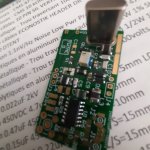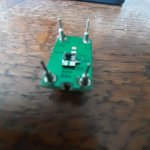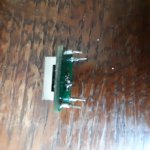My conclusion was based on evidence provided by you and Andrea.
I don't believe you. I think you formed that conclusion a long time ago. Then you now cherry-picked selected statements of opinion by Andrea and by me to make up a story that fits your agenda.
Otherwise, are you now saying Andrea's opinions and or my opinions, tentative or otherwise, are all of a sudden in your opinion good, solid engineering evidence that you will rely on to form more conclusions in the future, whether or not they fit your preexisting agenda?
EDIT:
BTW, DAC_Lite was using Andrea's clocks. Nobody claimed it would have sounded as good with lesser clocks.
Last edited:
The conclusion I made based on the evidence you provided is valid regardless of what I believe.
If really true, okay. I will give you another opinion that your can use to correct your faulty previous conclusion:
Phase noise matters. Period. However for a particular dac architecture, at some point further improvements beyond a certain level can reach a point of diminishing returns. That said, most commercial dacs, including D90, have not reached that point of diminishing returns.
Furthermore, most clocking system designs that rely on high speed digital design techniques will not reach that point either. Clocks are analog RF. There is a sensitive sine wave oscillator inside. Ground or signal currents flowing under the clock can be enough to corrupt its output (which is nothing new, its old analog RF stuff). There are a number of other things to be very careful about too.
I will be available to keep giving you opinions until you form a correct conclusion. Happy to be of service!
Jumping in with a question. What is the least discriminating solution/method/component etc ?Furthermore, most clocking system designs that rely on high speed digital design techniques will not reach that point either. Clocks are analog RF. There is a sensitive sine wave oscillator inside. Ground or signal currents flowing under the clock can be enough to corrupt its output (which is nothing new, its old analog RF stuff). There are a number of other things to be very careful about.
I don't have any need to change my conclusion but you obviously have issues with reading comprehension as I have not said that phase noise does not matter. I just said that it is not as important as some here claim. I have also never said that clocking implementation is not important. IMO it is actually more important than ultra low close-in phase noise. And as was already discussed in this thread based on measurements Topping D90 has issues with clocking and Vref implementations. I doubt those can be fixed by using a clock having lower close-in phase noise.Phase noise matters. Period. However for a particular dac architecture, at some point further improvements beyond a certain level can reach a point of diminishing returns. That said, most commercial dacs, including D90, have not reached that point of diminishing returns.
Furthermore, most clocking system designs that rely on high speed digital design techniques will not reach that point either. Clocks are analog RF. There is a sensitive sine wave oscillator inside. Ground or signal currents flowing under the clock can be enough to corrupt its output (which is nothing new, its old analog RF stuff). There are a number of other things to be very careful about too.
What is the least discriminating solution/method/component etc ?
I have written about parts of it it in various threads.
Starts with using the bypass caps recommended by @diyiggy.
Keep both clocks fully running at all times even when the dac is otherwise powered off. Don't switch between clocks using the enable pins on the clock modules.
Leave PCB keepouts under the clock modules.
Use a low noise dedicated voltage regulator. Resistor load its output for optimum performance.
Use clock buffer chips to distribute clock signals, don't use the clock modules to drive loads other than the buffers.
Design with the clock buffer chips as carefully as you do the clock modules themselves.
That should get you off to a pretty good start.
You made an unqualified blanket statement that it 'doesn't matter that much?'...I have not said that phase noise does not matter.
If so, it certainly can matter a lot if the rest of the dac design is up to snuff. If the dac design isn't good enough (regardless of the AP numbers), the clock quality will be the least of its problems.
EDIT: Okay enough of arguing. I will give this a rest.
Don't put words in my mouth. If you quote please do it properly.You made an unqualified statement that 'it doesn't matter that much?'
If you quote please do it properly.
My apologies.
You concluded: "So a reasonable conclusion is that Andrea's claims regarding the importance of low close-in phase noise are exaggerations."
You later followed up with: "If a poor oscillator is only very slightly inferior to Andrea's clocks then it is a totally reasonable conclusion that low close-in phase noise is not that important."
Don't agree with either of those, myself. Good day.
Last edited:
That should get you off to a pretty good start.
Forgot to add:
Don't use ferrites on clock module or buffer power.
@Markw4 Why not start an "DAC Master Clocks" education thread were the goal is to you know, educate, evolve the understanding, collect information and share said information about, such that those who want to know and learn as well as obtain the least discriminating clocks or solutions thereof can hangout and help one another.
I am certainly not the person to do that since I know frighteningly little about the subject. The only one who have products that as far as I know, take the clocks or potential, to a higher level and accuracy than most reputable manufacturers (not all) is, A.Mori / @The Well Audio
I am certainly not the person to do that since I know frighteningly little about the subject. The only one who have products that as far as I know, take the clocks or potential, to a higher level and accuracy than most reputable manufacturers (not all) is, A.Mori / @The Well Audio
D
Deleted member 537459
The educational thread existed but was closed@Markw4 Why not start an "DAC Master Clocks" education thread were the goal is to you know, educate, evolve the understanding, collect information and share said information about, such that those who want to know and learn as well as obtain the least discriminating clocks or solutions thereof can hangout and help one another.
I am certainly not the person to do that since I know frighteningly little about the subject. The only one who have products that as far as I know, take the clocks or potential, to a higher level and accuracy than most reputable manufacturers (not all) is, A.Mori / @The Well Audio
https://www.diyaudio.com/community/...phase-noise-jitter-crystal-oscillator.261651/
I think #5088 summed that up pretty Well 
https://www.diyaudio.com/community/...ystal-oscillator.261651/page-255#post-6843961
I always wondered why "well" in thread title was spelled with a capital W - last evening it finally dawned on me seeing Andrea coming back with a new user name or perhaps it is a ghost writer - language is a little to polished and correct - it was the name of a commercial endeavour and part of a gerilla advertisement scheme.. well o well.... ;-)
//
https://www.diyaudio.com/community/...ystal-oscillator.261651/page-255#post-6843961
I always wondered why "well" in thread title was spelled with a capital W - last evening it finally dawned on me seeing Andrea coming back with a new user name or perhaps it is a ghost writer - language is a little to polished and correct - it was the name of a commercial endeavour and part of a gerilla advertisement scheme.. well o well.... ;-)
//
Well putI think #5088 summed that up pretty Well
Bear in mind that some of the clocking advise given by Markw4 were just subjective opinions. It is easy to find opposite views elsewhere. Without solid evidence to back up every claim (or advise) this type of thread would soon dissolve into endless arguing (before it would be closed by moderators).@Markw4 Why not start an "DAC Master Clocks" education thread were the goal is to you know, educate, evolve the understanding, collect information and share said information about, such that those who want to know and learn as well as obtain the least discriminating clocks or solutions thereof can hangout and help one another.
I have written about parts of it it in various threads.
Starts with using the bypass caps recommended by @diyiggy.
Keep both clocks fully running at all times even when the dac is otherwise powered off. Don't switch between clocks using the enable pins on the clock modules.
Leave PCB keepouts under the clock modules.
Use a low noise dedicated voltage regulator. Resistor load its output for optimum performance.
Use clock buffer chips to distribute clock signals, don't use the clock modules to drive loads other than the buffers.
Design with the clock buffer chips as carefully as you do the clock modules themselves.
That should get you off to a pretty good start.
Here a picture frol the Ian clock II board with the tiny caps as a helper decoupling. I gave rhe trick long time ago now and since several diyers have adapted wirh their sauce...mixing it with F caps.
Iancanada finally adopted it in his FirstFifo at the bottom of the reclocker circuitry.
If reg ic are used I found some had better result than the often used lt3042. A full TSA7 reg solution is better for me subjectivly. Is it due to lower impedance ? Maybe but not sure...sometimes added inductance by longer wires 2 inch added between the output of the reg and the local acrylic gave me a nicer hearing result.
Not logical as the ground loop is larger! But look, some adds an inductor before crystal osci. ?! As a low pass ? I do not know.
But notice if you open Acussillon or Crystek cans as showed here ISCMS member for this last, you see both the NPO in the pF range needed and also a loosy xr7...think this xr7 one should be swapped by acrylics 0805 size despite the inductance is higher than the lower casing 0603 used there.
Also I am curious about smd silver mica to be used in crystal area...
Look at the former Andrea Discroll below...I swapped all the x7r by acrylics...no piezzo effect and 0805 size avialable and mater sound than the NPO or mkp. in the listening rendu. Now is it the piezzo or the ceramic dielectric that is less good for that ap than PEN or acrylic ? I do not know, it is above my head as an enthusiast.
Attachments
Last edited:
OT
@mocenigo,
you cited PMA's assertion about the "pointlessness" which is half-true (because neglecting the qualitative test methods and the question to whom it is pointless) but is still half-true the other way round, i.e. "that a properly controlled test is pointless without prior subjective less controlled evaluations".
Even the results of the best scientific experiments in our field can't tell the eternal truth, due to the fact that we rely on humans used as detectors. In the end, it comes to probabilities and there is always a chance that the results are wrong (wrt to the question under examination). Unfortunately, a lot of the "DBTs" in the audio field were not in the league of "best experiments".
PMA also mentioned in a recent post the lack of generalizability, and, as said before, that still would be the case even if a "proper DBT" would have been done. Still, it is just some people doing a controlled listening test in an unknown environment based on their own criteria.
And that equals the "truth from the mastering studio" that you've mentioned; unless you're able to listen to the record in exactly the same environment, you'll most likely never know, what the "sound of the truth" is.
Only standardized production, mastering and finally listening environments could provide an approach to this said "truth", but if you would like the result (in comparison to the original event) is still a different matter.
@mocenigo,
you cited PMA's assertion about the "pointlessness" which is half-true (because neglecting the qualitative test methods and the question to whom it is pointless) but is still half-true the other way round, i.e. "that a properly controlled test is pointless without prior subjective less controlled evaluations".
Even the results of the best scientific experiments in our field can't tell the eternal truth, due to the fact that we rely on humans used as detectors. In the end, it comes to probabilities and there is always a chance that the results are wrong (wrt to the question under examination). Unfortunately, a lot of the "DBTs" in the audio field were not in the league of "best experiments".
PMA also mentioned in a recent post the lack of generalizability, and, as said before, that still would be the case even if a "proper DBT" would have been done. Still, it is just some people doing a controlled listening test in an unknown environment based on their own criteria.
And that equals the "truth from the mastering studio" that you've mentioned; unless you're able to listen to the record in exactly the same environment, you'll most likely never know, what the "sound of the truth" is.
Only standardized production, mastering and finally listening environments could provide an approach to this said "truth", but if you would like the result (in comparison to the original event) is still a different matter.
Okay guy's, thanks for the input and links - much appreciated.
RME seems to have their jitter and clock figured out. Greater than 120dB of dynamic range.
https://www.rme-audio.de/steadyclock-fs.html
RME seems to have their jitter and clock figured out. Greater than 120dB of dynamic range.
https://www.rme-audio.de/steadyclock-fs.html
- Status
- Not open for further replies.
- Home
- Source & Line
- Digital Line Level
- The battle of the DACs, comparison of sound quality between some DACs


